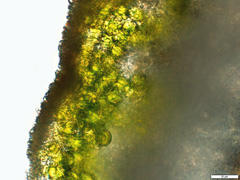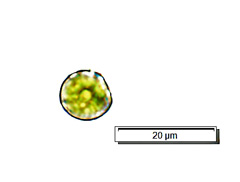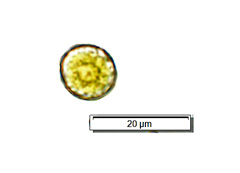Plants of the Gila Wilderness
Presented in Association with the
Western New Mexico University Department
of Natural Sciences
Trebouxia sp.
Trebouxia is a unicellular green alga approximately 8-10 microns in diameter that is by far the most common alga associated with lichens. Trebouxia is capable of surviving extremes of temperature and is found from desert to arctic environments. It is able to survive either as the photobiont in lichens or independently in nature. The Trebouxia species depicted here is isolated from the lichen Xanthoparmelia and is spherical in shape. Other members of the genus are differently shaped. The cell of this species contains a large green structure known as a chromatophore that takes up most of the volume of the cell. There is a central pyrenoid in the chromatophore, also visible in the pix below. The pyrenoid is the site of COČ concentration for the function of RUBISCO and carbon fixation.
Source of info:
Some New and Interesting Species of Trebouxia, a Genus of Lichenized Algae, Vernon Ahmadjian,
American Journal of Botany Vol. 47, No. 8 (Oct., 1960), pp. 677-683
Please click on an image for a larger file.

Trebouxia species, algal cells just below the cortex of the lichen Xanthoparmelia, photo Russ Kleinman & Karen Blisard, Pinos Altos Range, Pinos Altos, February 26, 2018

Trebouxia species, chromatophore with central pyrenoid easily visible, photo Russ Kleinman & Karen Blisard, Pinos Altos Range, Pinos Altos, February 26, 2018

Trebouxia species, chromatophore with central pyrenoid easily visible, photo Russ Kleinman & Karen Blisard, Pinos Altos Range, Pinos Altos, February 26, 2018
Back to the Index


